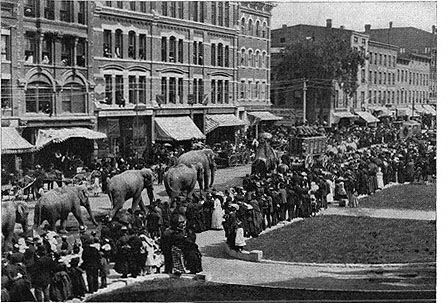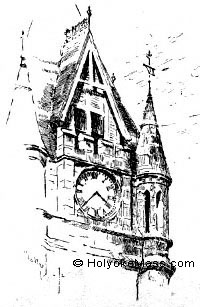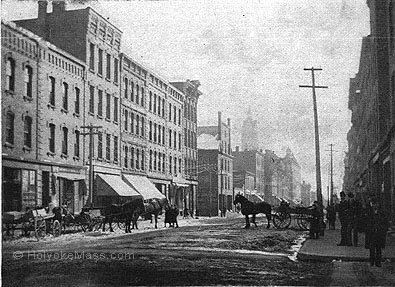
A Circus in Town
|
Many foreign laborers came to the town to aid in constructing the dam, and they built for themselves quite a village of little shanties on the ground now given up to Prospect Park and the region back of it. This village was known as the "Patch." It was an interesting community, and had many peculiar characteristics. A shanty was built by putting in four upright posts, to which rough boards were nailed, and then a roof of overlapping boards was put on top, places cut for a door and for two or three little half windows, and finally a lot of turf was cut and piled up to the eaves all about. A man would come into town in the morning, buy a thousand feet of hemlock boards, and have his shanty up by night, and the next morning would be ready to go to work on the dam and take boarders. Inside the shanty the earth was smoothed, scantling laid and a rude floor of boards put down. Underneath a little hole was dug for a cellar, and a trapdoor cut in the boards to get at it. A place was sawn in the roof and a bit of tin tacked around it, and the stovepipe run through the open air. Under the V of the roof was a loft, reached by a rough ladder, where the boarders slept.

The City Hall Clock
|
A partition of boards or, perchance, in other instances, an old blanket, usually cut in twain the lower room. On one side was a sleeping apartment, on the other the kitchen. In the loft were no beds, but there was straw in plenty, and here the boarders reclined something after the manner of sardines in a box. Board was rated at three dollars each per week. The food served was plenty and good, if not aesthetic in its nature. The bill of fare is, in the main, included in the following list: Hog’s head, corned beef, pork, coffee, bread, and "paraties." Most of the shanties were little affairs, but there was one with the length of forty feet, where thirty boarders were kept. The houses were ranged along irregular and narrow streets, about which the hogs, hens, and goats roamed at will, picking up the refuse. Behind the houses were little hovels for these creatures, though it is possible that in some cases they lived right with the family. The women of the neighborhood, as well as the children, were quite apt to go barefoot as long as mild weather lasted. Many houses were whitewashed within and kept with great neatness. Slovenliness makes no class distinctions. You may find it among the houses of the rich as well as the poor, and the wise as well as the ignorant. Neatness is a virtue all may have, no matter what their property or what their education.

High Street.
|

The New Y.M.C.A. Building.
|
The inhabitants of "The patch" came from various counties of Mother Ireland, and a clannish feeling seemed to prevail among those who came from the same region, which led to some desperate fights. Still, though quite free in the use of a shillalah and quick to anger, after a row the contestants were apt to be very good friends. While one of these diversions was going on the place was just about as safe as a powdermill, and those who were outside at such timer were very sure to keep outside. Then there were family troubles. A man would be combating his wife, and quite likely the children were engaged too—all in a turmoil of slapping, hitting and screeching. But it was best to let these things settle in their own way, for if an outsider interfered they would all turn around and give him "a most awful licking."
In the summer of 1849, when the dam was nearing completion, the cholera broke out in "The Patch." It was very hot, the life in the little village was very crowded, and the surroundings of the buildings were in many cases very uncleanly. This and the salt food they ate, which inclined them to drink great quantities of river water, brought on an epidemic. It made quick work. A man would be taken sick in the night and be dead before daylight. Whole families were swept away. There being no Catholic cemetery in Holyoke those days, the dead were carried to Chicopee. Religion, which up to this time they had little care for, assumed importance on the breaking out of the cholera, and it was then the first regular Catholic services were begun in the Old Exchange Hall, then just built, though in the summer previous occasional services had been conducted under a large elm tree which stood in a pasture where is now the corner of Dwight and Elm streets. The cholera lasted but a few weeks, and a little later the dam was finished and proven a complete success.
Now business began to boom; there were big mills going up, houses multiplying along the newly laid-out street, and the enthusiasts were going to have the place a city inside of five years. But in 1856 dull times came, the big Lyman mills were shut down all winter, and property owners of the vicinity were in the depths of despondency. The entire trade on High Street could have been cared for by a single person. Time hung heavy on the merchants’ hands, and on pleasant days you would usually find a group of them in an open lot in the vicinity pitching quoits while they watched for customers. On one day the proprietor of a certain shoe store remembers that he had but a single interruption, when he made a sale of one cent’s worth of shoe strings. On another day it had happened that there had been a light rain during the night, just enough to wet down the dust, and toward noon one of the merchants observed that a single wheel track had traversed High street. That was the only team that had been on the street that morning, and he called together his brother merchants to consider the matter. A committee was appointed to investigate and find out what the man’s business might have been, though there were those who thought he was not on business at all, but simply out for pleasure.
© Laurel O’Donnell 1996 - 2006, all rights reserved
This document may be downloaded for personal non-commercial use only
and may not be reproduced or distributed without permission in any format.
This is an edited adaptation from the original publication.
|